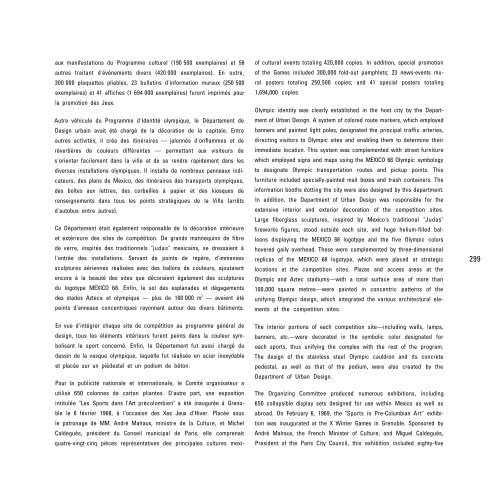Mexico City Olympic Games Official Report ... - LA84 Foundation
Mexico City Olympic Games Official Report ... - LA84 Foundation
Mexico City Olympic Games Official Report ... - LA84 Foundation
You also want an ePaper? Increase the reach of your titles
YUMPU automatically turns print PDFs into web optimized ePapers that Google loves.
aux manifestations du Programme culturel (190 500 exemplaires) et 58<br />
autres traitant d'événements divers (420 000 exemplaires). En outre,<br />
300 000 plaquettes pliables, 23 bulletins d'information muraux (250 500<br />
exemplaires) et 41 affiches (1 694 000 exemplaires) furent imprimés pour<br />
la promotion des Jeux.<br />
Autre véhicule du Programme d'Identité olympique, le Département de<br />
Design urbain avait été chargé de la décoration de la capitale. Entre<br />
autres activités, il créa des itinéraires — jalonnés d'oriflammes et de<br />
réverbères de couleurs différentes — permettant aux visiteurs de<br />
s'orienter facilement dans la ville et de se rendre rapidement dans les<br />
diverses installations olympiques. Il installa de nombreux panneaux indi-<br />
cateurs, des plans de <strong>Mexico</strong>, des itinéraires des transports olympiques,<br />
des boîtes aux lettres, des corbeilles à papier et des kiosques de<br />
renseignements dans tous les points stratégiques de la Ville (arrêts<br />
d'autobus entre autres).<br />
Ce Département était également responsable de la décoration intérieure<br />
et extérieure des sites de compétition. De grands mannequins de fibre<br />
de verre, inspirés des traditionnels "judas" mexicains, se dressaient à<br />
l'entrée des installations. Servant de points de repère, d'immenses<br />
sculptures aériennes réalisées avec des ballons de couleurs, ajoutaient<br />
encore à la beauté des sites que décoraient également des sculptures<br />
du logotype MEXICO 68. Enfin, le sol des esplanades et dégagements<br />
des stades Azteca et olympique — plus de 100 000 m 2 — avaient été<br />
peints d'anneaux concentriques rayonnant autour des divers bâtiments.<br />
En vue d'intégrer chaque site de compétition au programme général de<br />
design, tous les éléments intérieurs furent peints dans la couleur sym-<br />
bolisant le sport concerné. Enfin, le Département fut aussi chargé du<br />
dessin de la vasque olympique, laquelle fut réalisée en acier inoxydable<br />
et placée sur un piédestal et un podium de béton.<br />
Pour la publicité nationale et internationale, le Comité organisateur a<br />
utilisé 650 colonnes de carton pliantes. D'autre part, une exposition<br />
intitulée "Les Sports dans l'Art précolombien" a été inaugurée à Greno-<br />
ble le 6 février 1968, à l'occasion des Xes Jeux d'Hiver. Placée sous<br />
le patronage de MM. André Malraux, ministre de la Culture, et Michel<br />
Caldeguès, président du Conseil municipal de Paris, elle comprenait<br />
quatre-vingt-cinq pièces représentatives des principales cultures mexi-<br />
of cultural events totaling 420,000 copies. In addition, special promotion<br />
of the <strong>Games</strong> included 300,000 fold-out pamphlets; 23 news-events mu-<br />
ral posters totaling 250,500 copies; and 41 special posters totaling<br />
1,694,000 copies.<br />
<strong>Olympic</strong> identity was clearly established in the host city by the Depart-<br />
ment of Urban Design. A system of colored route markers, which employed<br />
banners and painted light poles, designated the principal traffic arteries,<br />
directing visitors to <strong>Olympic</strong> sites and enabling them to determine their<br />
immediate location. This system was complemented with street furniture<br />
which employed signs and maps using the MEXICO 68 <strong>Olympic</strong> symbology<br />
to designate <strong>Olympic</strong> transportation routes and pickup points. This<br />
furniture included specially-painted mail boxes and trash containers. The<br />
information booths dotting the city were also designed by this department.<br />
In addition, the Department of Urban Design was responsible for the<br />
extensive interior and exterior decoration of the competition sites.<br />
Large fiberglass sculptures, inspired by <strong>Mexico</strong>'s traditional "Judas"<br />
fireworks figures, stood outside each site, and huge helium-filled bal-<br />
loons displaying the MEXICO 68 logotype and the five <strong>Olympic</strong> colors<br />
hovered gaily overhead. These were complemented by three-dimensional<br />
replicas of the MEXICO 68 logotype, which were placed at strategic<br />
locations at the competition sites. Plazas and access areas at the<br />
<strong>Olympic</strong> and Aztec stadiums—with a total surface area of more than<br />
100,000 square metres—were painted in concentric patterns of the<br />
unifying <strong>Olympic</strong> design, which integrated the various architectural ele-<br />
ments of the competition sites.<br />
The interior portions of each competition site—including walls, lamps,<br />
banners, etc.—were decorated in the symbolic color designated for<br />
each sports, thus unifying the complex with the rest of the program.<br />
The design of the stainless steel <strong>Olympic</strong> cauldron and its concrete<br />
pedestal, as well as that of the podium, were also created by the<br />
Department of Urban Design.<br />
The Organizing Committee produced numerous exhibitions, including<br />
650 collapsible display sets designed for use within <strong>Mexico</strong> as well as<br />
abroad. On February 6, 1969, the "Sports in Pre-Columbian Art" exhibi-<br />
tion was inaugurated at the X Winter <strong>Games</strong> in Grenoble. Sponsored by<br />
André Malraux, the French Minister of Culture, and Miguel Caldeguès,<br />
President of the Paris <strong>City</strong> Council, this exhibition included eighty-five<br />
299
















